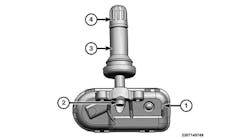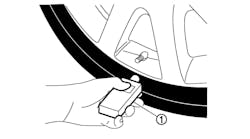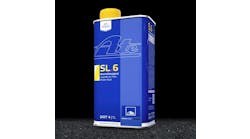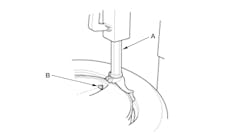DESCRIPTION and OPERATION
The BCM uses tire pressure sensors to monitor tire pressure. The sensors use radio signals to transmit the tire pressure to the RTM (remote transceiver module). The RTM sends the information to the BCM over a LIN. The tire pressure sensors are battery operated and mounted to the valve stems. The IPC (instrument panel cluster) illuminates the TPMS warning indicator and the message center displays a message when a fault is present or when the tire pressure falls below the low pressure limit.
The TPMS uses four valve stem mounted sensors to monitor tire pressure. These sensors wirelessly transmit tire pressure data to the RTM, which is a radio signal receiver that collects the tire pressure data and sends the information to the BCM along a LIN. All TPMS functions are controlled by the BCM. The BCM compares the tire pressure data sent by the RTM with a programmed tire pressure. This programmed pressure is specified on the VC label and cannot be changed. If the actual tire pressure is less than the programmed tire pressure, the BCM sends a low tire pressure message to the GWM (gateway module) along the HS-CAN1. The GWM then sends this message to the IPC along the HS-CAN3. The IPC responds by illuminating the TPMS warning indicator and displaying a low tire pressure message in the message center.
The TPMS sensors are trained (calibrated) to the BCM which records the unique identifier for each TPMS sensor and records the location of each sensor based on the training order. The BCM sends messages to the RTM by first sending the information along the HS-CAN1 to the GWM which then sends the information to the RTM along the MS-CAN.The diagnostic scan tool is useful in diagnosing TPMS concerns and may be used to verify the accuracy of the tire pressure data transmitted by the TPMS sensors. This is accomplished by comparing the BCM tire pressure PID data to the actual tire pressure using a digital tire pressure gauge. It is not necessary to train the sensors after a tire rotation on vehicles with the same front and rear tire pressures however, the BCM cannot recognize the sensor identifiers have been moved to different positions and retains the original position information for each sensor.
TPMS SENSOR ACTIVATION
- Turn the ignition switch to the ON position.
- Position the tool against the left front tire sidewall at the tire valve stem.
- Press the test button on the tool to activate the sensor. Activate the sensor at least twice.
- Repeat Steps two and three for the remaining tires.
TPMS SENSOR LOCATION CALIBRATION
The TPMS can be placed into learn mode using a diagnostic scan tool or manually where a diagnostic scan tool is not available.The horn will sound once and the TPMS indicator will flash if the training mode has been entered successfully. If equipped, the message center will display TRAIN left front (LF) tire.
Select Chassis / TPMS / Training Mode.
Enter Training Mode With IDS Scan Tool
Select Toolbox / Select BCM / Select BCM — TPMS Initialization.
Enter Training Mode Without Scan Tool
The horn will sound once and the TPMS indicator will flash if the training mode has been entered successfully. If equipped, the message center will display TRAIN left front (LF) tire.
- With the ignition OFF, press and release the brake pedal.
- Using the start/stop switch, position the ignition from OFF to RUN three times, ending in the RUN position.
- Press and release the brake pedal.
- Position the ignition to OFF position.
- Using the start/stop switch, position the ignition from OFF to RUN three times, ending in the RUN position.
TPMS Sensor Training Procedure
It may take up to six seconds to activate a tire pressure sensor. During this time, the tool must remain in place at the valve stem.
- Place the tool on the left front (LF) tire sidewall at the valve stem. Press and release the test button on the tool. The horn will sound briefly to indicate that the tire pressure sensor has been recognized by the BCM.
- Within two minutes of the horn sounding, place the tool on the right front (RF) tire sidewall at the valve stem and press and release the test button to train that tire pressure sensor.
- Repeat this step for the right rear (RR) and left rear (LR) tires. The procedure is completed after the last tire has been trained. When the training procedure is complete, the message center (if equipped) will display TIRE TRAINING COMPLETE. For vehicles not equipped with a message center, successful completion of the training procedure will be verified by positioning the ignition to OFF without the horn sounding. If the horn sounds twice when the ignition is positioned to OFF, the training procedure was not successful.
- Using the scan tool, locate the updated TPMS sensor identifiers trained to the BCM and document them on the applicable warranty claim.
- NOTE: This step is required to clear DTC B1182:55. Have the BCM exit the manufacturing mode and to make sure there are no other concerns with a newly programmed BCM. If the sensors are being trained due to the installation of a new BCM, clear any DTC and carry out the BCM on-demand self test.
REMOVAL and INSTALLATION
Disassembly
Failure to follow the instructions below may result in damage to the TPMS. The TPMS sensor is mounted to the valve stem. Removal of the valve stem requires demounting the tire from the wheel and removal of the TPMS sensor.
Use only the digital tire pressure gauge any time tire pressures are measured to be sure that accurate values are obtained.
- Remove the wheel and tire.
- Remove the valve stem core and fully deflate all air from the tire.
The valve stem is connected to the TPMS sensor. Do not pull the valve stem from the wheel, or damage to the sensor will occur. If a new TPMS sensor is being installed, remove and discard the valve stem-to-sensor screw and the sensor.
3. For a paddle-type tire machine, position the valve stem at the 12 o'clock or 6 o'clock position and the paddle at the 3 o'clock position. For a roller-type tire machine, align the valve stem with the roller at any position.
Do not allow the tire beads to move beyond the middle of the wheel when separating the beads from the wheels, as damage to the TPMS sensor may occur. Tire and valve stem position is critical to prevent damage to the TPMS sensor when using a paddle-type bead separator (as shown.)
Some machines may have a nylon roller bead separator at the 12 o'clock position instead of the paddle-type bead separator at the 3 o'clock position.
4. Place the wheel and tire assembly on the turntable of the tire machine with the valve stem at the 11:30 position and the machine arm at the 12 o'clock position and demount the outer bead from the wheel.
Index-mark the valve stem and wheel weight positions on the tire.
5. Reset the wheel and tire assembly on the turntable of the tire machine with the valve stem at the 11:30 position and the machine arm at the 12 o'clock position and dismount the inner bead from the wheel.
6. Remove and discard the TPMS sensor-to-valve stem screw. Separate the TPMS sensor from the valve stem. (A new valve stem must be installed whenever a new tire or wheel is installed.)
7. Using a suitable valve stem remover/installer, remove and discard the valve stem. Use the general equipment: wooden block. Use care not to damage the wheel surface when removing the valve stem.
When installing a new wheel, always install a new valve stem and sensor screw. Reuse the TPMS sensor from the previous wheel if possible. The TPMS will not have to be trained if the sensor is reused. If the TPMS sensor is being reused, inspect the TPMS sensor for damage and install a new sensor as necessary.
8. Position the new valve stem onto the TPMS sensor and install the new screw.
To prevent TPMS sensor and valve stem damage, the valve stem must be installed onto the TPMS sensor and then installed into the wheel as an assembly.
Assembly
Damage to the TPMS sensor may result if the tire mounting is not carried out as instructed.
- Using a suitable valve stem installer, install the new valve stem and TPMS sensor assembly.
It is important to pull the valve stem and TPMS sensor assembly through the wheel rim hole in a direction parallel to the valve stem hole axis. If the assembly is pulled through at an angle, damage to the valve stem and sensor assembly may occur.
Use care not to damage the wheel surface when installing the valve stem and TPMS sensor assembly. Lubricate the valve stem with soapy water and install the valve stem and TPMS sensor assembly into the wheel using a block of wood and a suitable valve stem installer.
2. Position the wheel on the turntable of the tire machine, then lubricate and position the bottom bead of the tire on the wheel.
Lubricate the tire beads using a suitable fast-drying, corrosion-inhibiting tire bead lubricant.
Do not mount the tire at this time.
3. Position the wheel to align the valve stem with the machine arm, at the 6 o'clock position, and mount the bottom bead of the tire.
4. Reposition the wheel to align the valve stem with the machine arm at the 6 o'clock position, and mount the top bead of the tire.
5. Inflate the tire to the pressure specified on the label located on the driver door or door pillar.
Use only the digital tire pressure gauge any time tire pressures are measured to be sure that accurate values are obtained.
6. Follow all of the steps below only if the tire beads do not seat at the specified inflation pressure. Failure to follow these steps may result in serious personal injury.
- Relubricate the tire bead and wheel bead seat area.
- Install a remote valve and pressure gauge.
- Wear eye and ear protection and stand a minimum of 12 feet away from the wheel and tire assembly.
- Inflate the tire using the remote valve and tire gauge until the beads have seated or until the pressure gauge is 20 psi more than maximum inflation pressure on tire sidewall. If beads have not seated, deflate the tire and proceed to the next step.
- Place the wheel and tire assembly in an OSHA-approved tire safety cage.
- Inflate the tire using the remote valve and pressure gauge until the beads have seated or until the pressure gauge is 40 psi more than maximum inflation pressure on the tire sidewall. Do not exceed 40 psi above the maximum pressure on tire sidewall. Install a new tire if the beads do not seat at this pressure.
7. Install the wheel and tire.
TORQUE SPECIFICATIONS:
DESCRIPTION: Lug Nut
SPECIFICATION: 13 lb.in (1.5 Nm)




